用Python玩微信(非常詳細)
代碼放在這裏:wzyonggege/python-wechat-itchat
詞雲那裏可以換成小黃人圖片
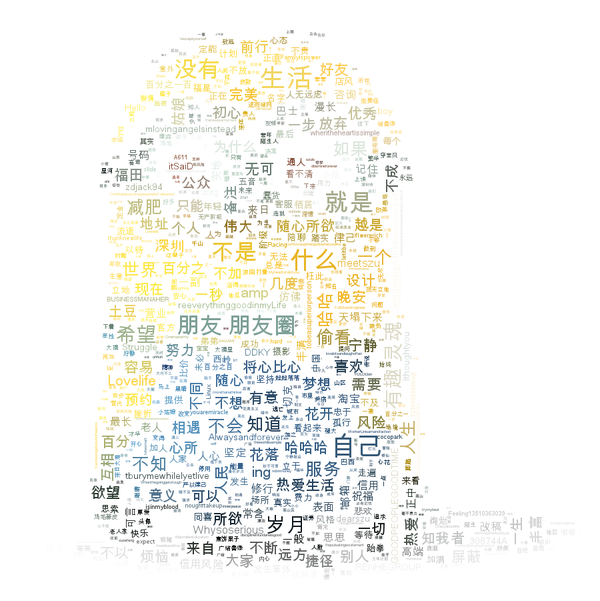
---------------------------------------------------------------------------------------------------
0. itchat
最近研究了一些微信的玩法,我們可以通過網頁版的微信微信網頁版,掃碼登錄後去抓包爬取信息,還可以post去發送信息。
然後發現了itchat這個開源項目,作者是@LittleCoder,已經把微信的接口完成了,大大的方便了我們對微信的挖掘,以下的功能也通過itchat來實現。
安裝itchat這個庫
pip install itchat
先來段簡單的試用,實現微信的登錄,運行下面代碼會生成一個二維碼,掃碼之後手機端確認登錄,就會發送一條信息給‘filehelper’,這個filehelper就是微信上的文件傳輸助手。
import itchat
# 登錄
itchat.login()
# 發送消息
itchat.send(u‘你好‘, ‘filehelper‘)
除了登錄和發送消息我們還可以這麽來玩,往下走~
1. 微信好友男女比例
想統計下自己微信裏好友的性別比例,當然也是很簡單,先獲取好友列表,統計列表裏性別計數
import itchat
# 先登錄
itchat.login()
# 獲取好友列表
friends = itchat.get_friends(update=True)[0:]
# 初始化計數器,有男有女,當然,有些人是不填的
male = female = other = 0
# 遍歷這個列表,列表裏第一位是自己,所以從"自己"之後開始計算
# 1表示男性,2女性
for i in friends[1:]:
sex = i["Sex"]
if sex == 1:
male += 1
elif sex == 2:
female += 1
else:
other += 1
# 總數算上,好計算比例啊~
total = len(friends[1:])
# 好了,打印結果
print u"男性好友:%.2f%%" % (float(male) / total * 100)
print u"女性好友:%.2f%%" % (float(female) / total * 100)
print u"其他:%.2f%%" % (float(other) / total * 100)
好看看結果:

(好吧,暴露了我男性友人較多的真相~~)
好像不夠直觀,有興趣的朋友可以加上可視化的展示,我這裏用基於python的Echarts(有機會再細講)
先安裝了
pip install echarts-python
展示比例一般使用百分比圓餅表吧
# 使用echarts,加上這段
from echarts import Echart, Legend, Pie
chart = Echart(u‘%s的微信好友性別比例‘ % (friends[0][‘NickName‘]), ‘from WeChat‘)
chart.use(Pie(‘WeChat‘,
[{‘value‘: male, ‘name‘: u‘男性 %.2f%%‘ % (float(male) / total * 100)},
{‘value‘: female, ‘name‘: u‘女性 %.2f%%‘ % (float(female) / total * 100)},
{‘value‘: other, ‘name‘: u‘其他 %.2f%%‘ % (float(other) / total * 100)}],
radius=["50%", "70%"]))
chart.use(Legend(["male", "female", "other"]))
del chart.json["xAxis"]
del chart.json["yAxis"]
chart.plot()
登登登登~
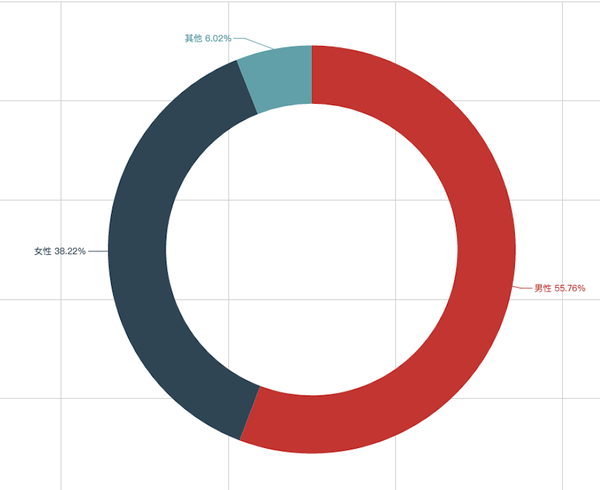
2. 好友個性簽名詞雲
獲取好友列表的時候,返回的json信息中還看到了有個性簽名的信息,腦洞一開,把大家的個性簽名都抓下來,看看高頻詞語,還做了個詞雲。
# coding:utf-8
import itchat
# 先登錄
itchat.login()
# 獲取好友列表
friends = itchat.get_friends(update=True)[0:]
for i in friends:
# 獲取個性簽名
signature = i["Signature"]
print signature
先全部抓取下來
打印之後你會發現,有大量的span,class,emoji,emoji1f3c3等的字段,因為個性簽名中使用了表情符號,這些字段都是要過濾掉的,寫個正則和replace方法過濾掉
for i in friends:
# 獲取個性簽名
signature = i["Signature"].strip().replace("span", "").replace("class", "").replace("emoji", "")
# 正則匹配過濾掉emoji表情,例如emoji1f3c3等
rep = re.compile("1f\d.+")
signature = rep.sub("", signature)
print signature
接來下用jieba分詞,然後制作成詞雲,首先要安裝jieba和wordcloud庫
pip install jieba
pip install wordcloud
代碼
# coding:utf-8
import itchat
import re
itchat.login()
friends = itchat.get_friends(update=True)[0:]
tList = []
for i in friends:
signature = i["Signature"].replace(" ", "").replace("span", "").replace("class", "").replace("emoji", "")
rep = re.compile("1f\d.+")
signature = rep.sub("", signature)
tList.append(signature)
# 拼接字符串
text = "".join(tList)
# jieba分詞
import jieba
wordlist_jieba = jieba.cut(text, cut_all=True)
wl_space_split = " ".join(wordlist_jieba)
# wordcloud詞雲
import matplotlib.pyplot as plt
from wordcloud import WordCloud
import PIL.Image as Image
# 這裏要選擇字體存放路徑,這裏是Mac的,win的字體在windows/Fonts中
my_wordcloud = WordCloud(background_color="white", max_words=2000,
max_font_size=40, random_state=42,
font_path=‘/Users/sebastian/Library/Fonts/Arial Unicode.ttf‘).generate(wl_space_split)
plt.imshow(my_wordcloud)
plt.axis("off")
plt.show()
運行代碼
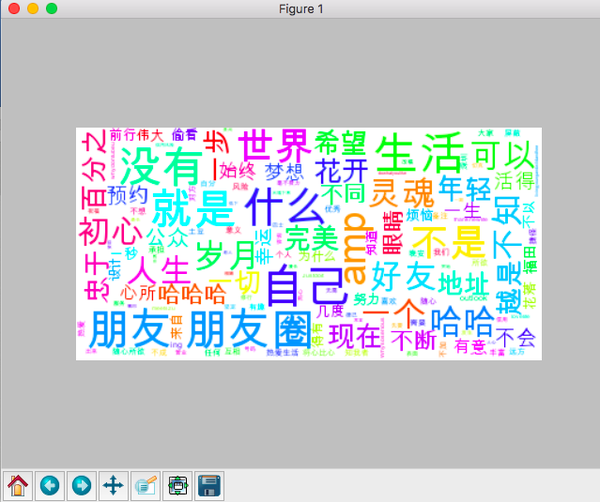 這。。好像有點醜,根據wordcloud用法,我可以找一張圖來生成配色方案,我這裏找了一張微信的logo
這。。好像有點醜,根據wordcloud用法,我可以找一張圖來生成配色方案,我這裏找了一張微信的logo
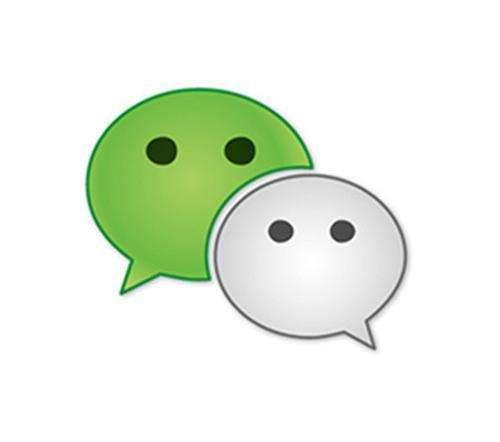
修改一下代碼
# wordcloud詞雲
import matplotlib.pyplot as plt
from wordcloud import WordCloud, ImageColorGenerator
import os
import numpy as np
import PIL.Image as Image
d = os.path.dirname(__file__)
alice_coloring = np.array(Image.open(os.path.join(d, "wechat.jpg")))
my_wordcloud = WordCloud(background_color="white", max_words=2000, mask=alice_coloring,
max_font_size=40, random_state=42,
font_path=‘/Users/sebastian/Library/Fonts/Arial Unicode.ttf‘) .generate(wl_space_split)
image_colors = ImageColorGenerator(alice_coloring)
plt.imshow(my_wordcloud.recolor(color_func=image_colors))
plt.imshow(my_wordcloud)
plt.axis("off")
plt.show()
# 保存圖片 並發送到手機
my_wordcloud.to_file(os.path.join(d, "wechat_cloud.png"))
itchat.send_image("wechat_cloud.png", ‘filehelper‘)
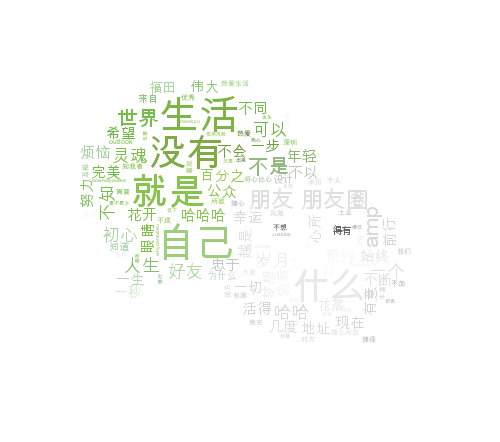
嗯~好像還可以,這是Mac下生成的,附一個win10下生成的
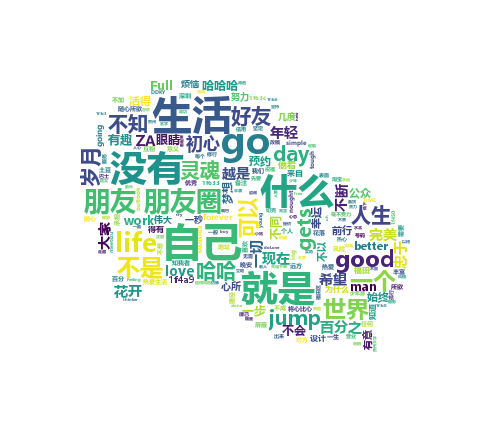
3. 微信自動回復
接著來實現一個類似qq上的自動回復,原理就是接收到消息,就發消息回去,同時發一條給文件助手,就可以在文件助手中統一查看消息。
代碼很簡單,來看看
#coding=utf8
import itchat
# 自動回復
# 封裝好的裝飾器,當接收到的消息是Text,即文字消息
@itchat.msg_register(‘Text‘)
def text_reply(msg):
# 當消息不是由自己發出的時候
if not msg[‘FromUserName‘] == myUserName:
# 發送一條提示給文件助手
itchat.send_msg(u"[%s]收到好友@%s 的信息:%s\n" %
(time.strftime("%Y-%m-%d %H:%M:%S", time.localtime(msg[‘CreateTime‘])),
msg[‘User‘][‘NickName‘],
msg[‘Text‘]), ‘filehelper‘)
# 回復給好友
return u‘[自動回復]您好,我現在有事不在,一會再和您聯系。\n已經收到您的的信息:%s\n‘ % (msg[‘Text‘])
if __name__ == ‘__main__‘:
itchat.auto_login()
# 獲取自己的UserName
myUserName = itchat.get_friends(update=True)[0]["UserName"]
itchat.run()
運行後會保持登錄狀態,開啟自動回復模式,手機上查看:
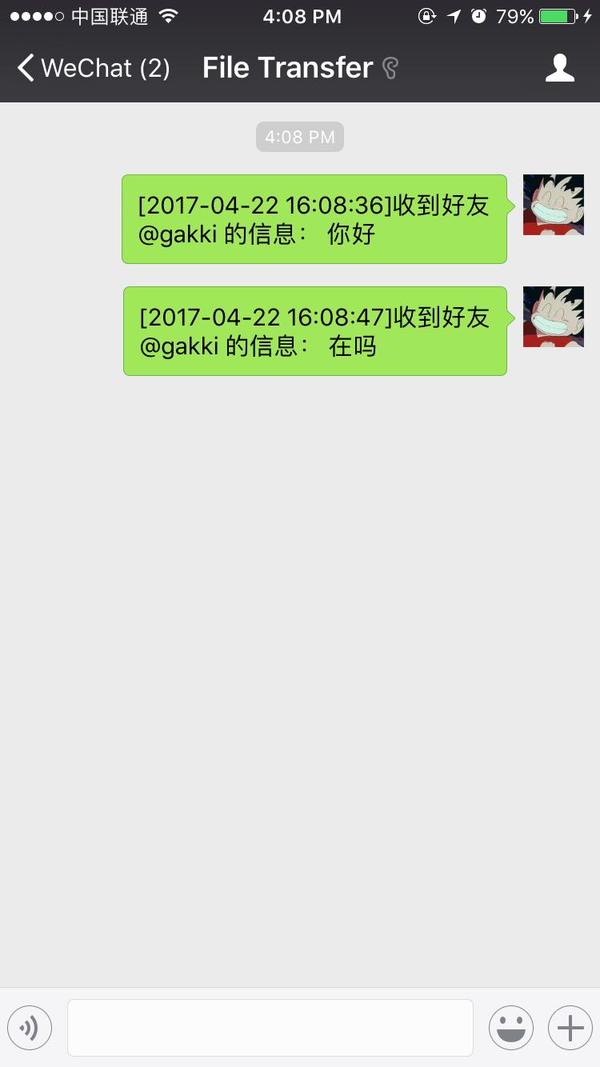
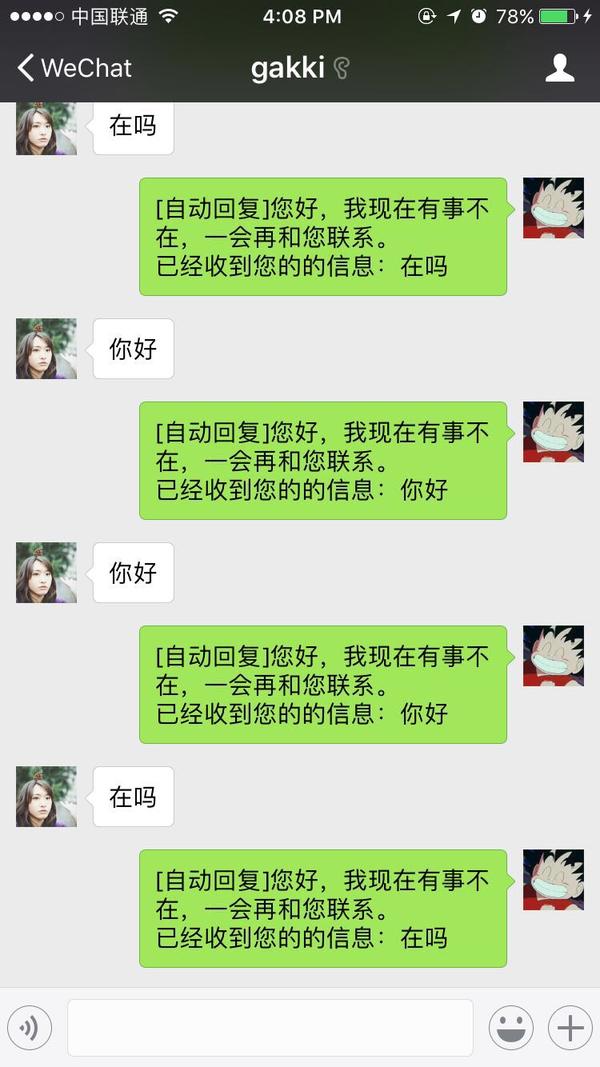 當然,除了文字Text信息,還可以接收圖片(表情包算圖片),語音,名片,地理位置,分享和類型為Note的信息(就是有人提示類的消息,例如撤回消息),把裝飾器寫成下面形式即可接受,大家可以試試
當然,除了文字Text信息,還可以接收圖片(表情包算圖片),語音,名片,地理位置,分享和類型為Note的信息(就是有人提示類的消息,例如撤回消息),把裝飾器寫成下面形式即可接受,大家可以試試
@itchat.msg_register([‘Map‘, ‘Card‘, ‘Note‘, ‘Sharing‘, ‘Picture‘])
學習過程中遇到什麽問題或者想獲取學習資源的話,歡迎加入學習交流群
626062078,我們一起學Python!
用Python玩微信(非常詳細)
